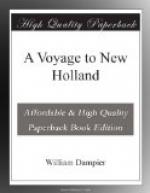Of the inhabitants and their commodities.
The people in general are black, or at least of a mixed colour, except only some few of the better sort, namely the governor, the bishop, some gentlemen, and some of the padres; for some of these also are black. The people about Praya are thievish; but these of St. Jago Town, living under their governor’s eye, are more orderly, though generally poor, having little trade: yet besides chance ships of other nations there come hither a Portuguese ship or two every year, in their way to Brazil. These vend among them a few European commodities, and take of their principal manufactures, namely striped cotton cloth which they carry with them to Brazil. Here is also another ship comes hither from Portugal for sugar, their other manufacture, and returns with it directly thither: for it is reported that there are several small sugar-works on this island from which they send home near 100 ton every year; and they have plenty of cotton growing up in the country wherewith they clothe themselves, and send also a great deal to Brazil. They have vines of which they make some wine; but the European ships furnish them with better; though they drink but little of any. Their chief fruits are (besides plantains in abundance) oranges, lemons, citrons, melons (both musk and watermelons) limes, guavas, pomegranates, quinces, custard-apples, and papaws, etc.
Of the custard-apple, st. Jago road.
The custard-apple (as we call it) is a fruit as big as a pomegranate, and much of the same colour. The outside husk, shell, or rind, is for substance and thickness between the shell of a pomegranate, and the peel of a seville orange; softer than this, yet more brittle than that. The coat or covering is also remarkable in that it is beset round with small regular knobs or risings; and the inside of the fruit is full of a white soft pulp, sweet and very pleasant, and most resembling a custard of any thing, both in colour and taste; from whence probably it is called a custard-apple by our English. It has in the middle a few small black stones or kernels; but no core, for it is all pulp. The tree that bears this fruit is about the bigness of a quince-tree, with long, small, and thick-set branches spread much abroad:




